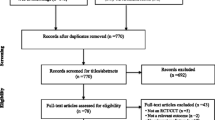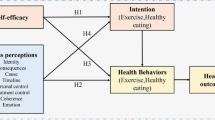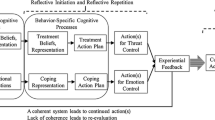Abstract
This study tested a longitudinal model examining the roles of motivation and perceived competence in the prediction of physical activity (PA) and healthy eating (HE) in individuals with cardiovascular diseases, and the effects of adopting these behaviors on individuals’ health. Participants completed measures of global motivation (baseline), contextual motivation and perceived competence for PA and HE (3 months), and self-reports of PA and HE behaviors (6 months). Physiological indicators and life satisfaction were assessed at the baseline and at 12 months. Structural equation modeling supported that individuals with self-determined motivation (SDM) were more likely to feel competent in changing their lifestyle and to engage in moderate and strenuous (vs. mild) exercise and HE behaviors, which had beneficial effects on individuals’ physiological and psychological health. This research confirms the respective roles of SDM and perceived competence in the health behavior change process and emphasizes the key function of SDM in the adherence of healthy behaviors over time.

Similar content being viewed by others
References
Alberti, K., Eckel, R., Grundy, S., Zimmet, P., Cleeman, J., Donato, K., et al. (2009). Harmonizing the metabolic syndrome: A joint interim statement of the International Diabetes Federation Task Force on Epidemiology and Prevention; National Heart, Lung, and Blood Institute; American Heart Association; World Heart Federation; International Atherosclerosis Society; and International Association for the study of obesity. Circulation, 120, 1640–1650. doi:10.14341/2071-8713-5281.
American Stroke Association (2014). Heart disease and stroke statistics: At a glance. https://www.heart.org/idc/groups/ahamah-public/@wcm/@sop/@smd/documents/downloadable/ucm_470704.pdf.
Bandura, A. (1997). Self-efficacy: The exercise of control. New York: Freeman.
Baumann, M., Tchicaya, A., Vanderpool, K., Lorentz, N., & Le Bihan, E. (2015). Life satisfaction, cardiovascular risk factors, unhealthy behaviors and socioeconomonic inequality, 5 years after coronary angiography. BMC Public Health, 15(15), 668. doi:10.1186/s12889-015-2047-0.
Deci, E., & Ryan, R. (2002). Handbook of self-determination research. Rochester: University of Rochester Press.
Deci, E., & Ryan, R. (2008). Facilitating optimal motivation and psychological well-being across life’s domains. Canadian Psychology, 49, 14–23. doi:10.1037/0708-5591.49.1.14.
U.S. Department of Health and Human Services. (1999). Achieving a moderately active lifestyle. In U.S.D.H.H.S., Public Health Service, Center for Disease Control and Prevention, National Center for Chronic Disease Prevention and Health Promotion & Division of Nutrition and Physical Activity (Eds.), Promoting physical activity: A guide for community action (pp. 15–37). Champaign, IL: Human Kinetics.
Diener, E., Emmons, R., Larsen, R., & Griffin, S. (1985). The satisfaction with life scale. Journal of Personality Assessment, 49, 71–76. doi:10.1207/s15327752jpa4901_13.
Ferguson, Y. L., & Sheldon, K. M. (2010). Should goal-strikers think about “why” or ‘how” to strive? It depends on their skill level. Motivation and Emotion, 34, 253–265. doi:10.1007/s11031-010-9174-9.
Fortier, M., Sweet, S., O’Sullivan, T., & Williams, G. (2007). A self-determination process model of physical activity adoption in the context of a randomized controlled trial. Psychology of Sport and Exercise, 8, 741–757. doi:10.1016/j.psychsport.2006.10.006.
Godin, G. (2011). Commentary: The Godin-Shephard Leisure-Time Physical Activity Questionnaire. Health & Fitness Journal of Canada, 4, 18–22. doi:10.2466/03.27.PMS.120v19x7.
Godin, G., & Shephard, R. (1985). A simple method to assess exercise behavior in the community. Canadian Journal of Applied Sciences, 10, 141–146. doi:10.4135/9781446261910.
Guertin, C., Rocchi, M., Pelletier, L., Émond, C., & Lalande, G. (2015). The role of motivation and the regulation of eating on the physical and psychological health of patients with cardiovascular disease. Journal of Health Psychology, 20, 543–555. doi:10.1177/1359105315573471.
Hagger, M., Chatzisarantis, N., & Harris, J. (2006). The process by which relative autonomous motivation affects intentional behavior: Comparing effects across dieting and exercise behaviors. Motivation and Emotion, 30, 307–321. doi:10.1007/s11031-006-9046-5.
Hartmaan, C., Dohle, S., & Siegrist, M. (2015). A self-determination theory approach to adults’ healthy body weight motivation: A longitudinal study focussing on food choices and recreational physical activity. Psychology and Health, 30, 924–948. doi:10.1080/08870446.2015.1006223.
Heart and Stroke Foundation of Canada. (2014). Heart and Stroke Recovery Road: An information guide for heart patients and their families. https://www.pdffiller.com/jsfiller/?projectId=102418070#f1b39fe6029e4f55a205d16c0b5c67b1.
Heart and Stroke Foundation of Canada. (2015). Statistics. http://www.heartandstroke.on.ca/site/c.pvI3IeNWJwE/b.3581729/k.359A/Statistics.htm.
IBM. (2013). IBM SPSS Statistics for Windows, Version 22.0. Armonk, NY: IBM Corp.
Jensen, M. D., Ryan, D. H., Apovian, C. M., Ard, J. D., Comuzzie, A. G., Donato, K. A., et al. (2013). AHA/ACC/TOS guideline for the management of overweight and obesity in adults: A report of the American College of Cardiology/American Heart Association Task Force on Practice Guidelines and The Obesity Society. Circulation, 129, S139–S140. doi:10.1161/01.cir.0000437739.71477.ee.
Koivumaa-Honkanen, H., Honkanen, R., Viinamaki, H., Heikkila, K., Kaprio, J., Koskenvuo, M., et al. (2000). Self-reported life satisfaction and 20-year mortality in healthy Finnish adults. American Journal of Epidemiology, 10, 983–991. doi:10.1093/aje/152.10.983.
Labonté, M.-È., Cyr, A., Baril-Gravel, L., Royer, M.-M., & Lamarche, B. (2012). Validity and reproducibility of a web-based, self-administered food frequency questionnaire. European Journal of Clinical Nutrition, 66, 166–173. doi:10.1038/ejcn.2011.163.
McArdle, J., & Nesselroade, J. (2014). Longitudinal data analysis using structural equation modeling. Washington, DC: American Psychological Association.
Millen, J., & Bray, S. (2009). Promoting self-efficacy and outcome expectations to enable adherence to resistance training after cardiac rehabilitation. Journal of Cardiovascular Nurses, 24, 316–327. doi:10.1097/JCN.0b013e3181a0d256.
Miller, M., Stone, J., Ballantyne, C., Bittner, V., Criqui, M., Ginsberg, H., et al. (2011). Triglycerides and cardiovascular disease: A scientific statement from the American Heart Association. Circulation, 123, 2292–2333. doi:10.1161/CIR.0b013e3182160726.
Ng, J., Ntoumanis, N., Thogersen-Ntoumani, C., Deci, E., Ryan, R., Duda, J., et al. (2012). Self-determination theory applied to health contexts: A meta-analysis. Perspectives on Psychological Science, 7, 325–340. doi:10.1177/1745691612447309.
Otis, N., & Pelletier, L. G. (2008). Women’s regulation styles for eating behaviors and outcomes: The mediating role of approach and avoidance food planning. Motivation and Emotion, 32, 55–67. doi:10.1007/s11031-008-9083-3.
Pate, R., Pratt, M., Blair, S., Haskell, W., Macera, C., Bouchard, C., et al. (1995).Physical activity and public health: a recommendation from the centers for Disease Control and Prevention and the American College of Sports Medicine. The Journal of the American Medical Association, 273, 402–407. doi:10.1001/jama.1995.03520290054029.
Patrick, H., & Williams, G. (2012). Self-determination theory: Its application to health behavior and complementarity with motivational interviewing. International Journal of Behavioral Nutrition and Physical Activity, 9, 18. doi:10.1186/1479-5868-9-18.
Pelletier, L., & Dion, S. (2007). An examination of general and specific motivational mechanisms for the relations between body dissatisfaction and eating behaviours. Journal of Social and Clinical Psychology, 3, 303–333. doi:10.1521/jscp.2007.26.3.303.
Pelletier, L., Dion, S., Slovinec-D’Angelo, M., & Reid, R. (2004). Why do you regulate what you eat? Relationships between forms of regulation, eating behaviors, sustained dietary change, and psychological adjustment. Motivation and Emotion, 28, 245–277. doi:10.1023/B:MOEM.0000040154.40922.14.
Rodgers, W. M., Markland, D., Seizier, A. M., Murray, T. C., & Wilson, P. M. (2014). Distinguishing perceived competence and self-efficacy: An example from exercise. Research Quarterly for Exercise and Sport, 85, 527–538. doi:10.1080/02701367.2014.961050.
Rosel, J. R., & Plewis, I. (2008). Longitudinal data analysis with structural equations. Methodology European Journal of Research Methods for the Behavioral and Social Sciences, 4, 38–50. doi:10.1027/1614-2241.4.1.37.
Rothman, A., Baldwin, A., & Hertel, A. (2004). Self-regulation and behavior change: Disentangling behavioral initiation and behavioral maintenance. The handbook of self- regulation (pp 130–148). New York: Guilford Press.
Russell, K., & Bray, S. (2009). Self-determined motivation predicts independent, home-based exercise following cardiac rehabilitation. Rehabilitation Psychology, 54, 150–156. doi:10.1037/a0015595.
Ryan, R., & Deci, E. (2000). Self-determination theory and the facilitation of intrinsic motivation, social development, and well-being. American Psychologist, 55, 68–78. 10.1037/110003-066X.55.1.68.
Ryan, R. M., & Connell, J. P. (1989). Perceived locus of causality and internalization: Examining reasons for acting in two domains. Journal of Personality and Social Psychology, 57, 749–761.
Sheldon, K., & Elliot, A. (1999). Goal striving, need satisfaction, and longitudinal well-being: The self-concordance model. Journal of Personality and Social Psychology, 76, 482–497. doi:10.1037/0022-3514.76.3.482.
Silva, M., Markland, D., Carraça, E., Vieira, P., Coutinho, S., Minderico, C., et al. (2011). Exercise autonomous motivation predicts 3-years weight loss in women. Medicine & Science in Sports and Exercise, 43, 728–737. doi:10.1249/MSS.0b013e3181f3818f.
Silva, M., Markland, D., Minderico, C., Vieira, P., Castro, M., Coutinho, S., et al. (2008). A randomized controlled trial to evaluate self-determination theory for exercise adherence and weight control: rationale and intervention description. BMI Public Health, 9, 234. doi:10.1186/1471-2458-8-234.
Slovinec-D’Angelo, M., Pelletier, L., Reid, R., & Huta, V. (2014). The roles of self-efficacy and motivation in the prediction of long-term adherence to exercise among patients with heart disease. Health Psychology, 33, 1344–1353. doi:10.1037/hea0000094.
Slovinec-D’Angelo, M., Reid, R., & Pelletier, L. (2007). A model for exercise behavior change regulation in patients with heart disease. Journal of Sport & Exercise Psychology, 29, 208–224. doi:10.1037/hea0000094.
Stevens, J., Katz, E., & Huxley, R. (2010). Associations between gender, age and waist circumference. European Journal of Clinical Nutrition, 64, 6–15. doi:10.1038/ejcn.2009.101.
Teixeira, P., Carraça, E., Marques, M., Rutter, H., Oppert, J-M., De Bourdeauhuij, I., et al. (2015). Successful behavior change in obesity interventions in adults: a systematic review of self-regulation mediators. BMC Medicine, 13, 84. doi:10.1186/s12916-015-0323-6.
Thompson, P., Buchner, D., Pina, I., Balady, G., Williams, M., Marcus, B., et al. (2003). Exercise and physical activity in the prevention and treatment of atherosclerotic cardiovascular disease: A statement from the council on clinical cardiology (subcommittee on exercise, rehabilitation, and prevention) and the council on nutrition, physical activity, and metabolism (subcommittee on physical activity). Circulation, 107, 3109–3116. doi:10.1161/01.CIR.0000075572.40158.77.
Vallerand, R. (1997). Toward a hierarchical model of intrinsic and extrinsic motivation. In M. P. Zanna (Ed.), Advances in experimental social psychology (pp. 271–360). New York: Academic Press.
Verloigne, M., De Bourdeaudhuij, I., Tanghe, A., D’Hondt, E., Theuwis, L., Vansteenkiste, M., et al. (2011). Self-determined motivation towards physical activity in adolescents treated for obesity: An observational study. International Journal of Behavioral Nutrition and Physical Activity, 8, 97. doi:10.1186/1479-5868-8-97.
Williams, G., & Deci, E. (1996). Internalization of biopsychosocial values by medical students: A test of self-determination theory. Journal of Personality and Social Psychology, 70, 767–779. doi:10.1037/0022-3514.70.4.7.
Williams, G., Gagné, M., Mushlin, A. I., & Deci, E. L. (2005). Motivation for behavior change in patients with chest pain. Health Education, 105, 304–321. doi:10.1108/09654280510602516.
Williams, G., Gagné, M., Ryan, R., & Deci, E. L. (2002). Facilitating autonomous motivation for smoking cessation. Health Psychology, 21, 40–50. doi:10.1037//0278-6133.21.1.40.
World Health Organization. (2008). Waist circumference and waist-hip ratio: Report of a WHO expert consultation (pp. 8–11). Geneva: World Health Organization.
Funding
This project was funded by a Pfizer Independent Medical Grant No. NRA2581119.
Author information
Authors and Affiliations
Corresponding author
Ethics declarations
Conflict of interest
All authors declare no conflict of interests.
Rights and permissions
About this article
Cite this article
Guertin, C., Pelletier, L.G., Émond, C. et al. Change in physical and psychological health over time in patients with cardiovascular disease: on the benefits of being self-determined, physically active, and eating well. Motiv Emot 41, 294–307 (2017). https://doi.org/10.1007/s11031-017-9608-8
Published:
Issue Date:
DOI: https://doi.org/10.1007/s11031-017-9608-8




